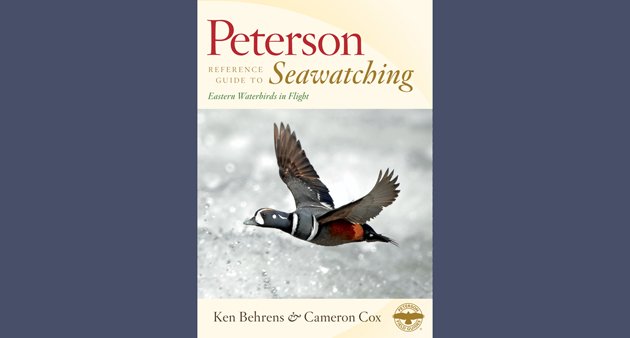
In the old days, I watched the Atlantic Ocean to enjoy the view—the wavering line between sky and water, the infinite shades of blue and green, the threatening height and roar of waves on a windy morning. Well, now I’m a birder and all that beauty is beside the point. My attention is focused on objects moving above the water, vaguely defined-in-the-fog shapes, some moving lyrically, some diving, occasionally flying in close enough so I can see a bit of black on the wing, red on the bill, and then moving frustratingly out of reach of eye and optics.
This, I am told, is seawatching, a birding activity in which one stands in one place, sometimes for hours, and watches for birds of the sea and lake and river. It is acceptable to point out other sea creatures–dolphins or whales or dragonflies–but the main goal is the observation and identification of the birds. It is a challenging activity. Not only do birds that fly over the ocean (or lake or river) tend to take on forms and colors not depicted in field guides, a number of these birds rarely approach shore and are seldom, if ever, seen on land south or north of zones of extreme climate. Which is why I am so excited about the publication of the Peterson Reference Guide to Seawatching: Eastern Waterbirds in Flight, by Ken Behrens and Cameron Cox, the latest title of the Peterson Reference Guides series published by Houghton Mifflin Harcourt. Written in the tradition of the classic Hawks in Flight, but very much a product of the experiences of its birder authors, this is a groundbreaking book that offers a new way of identifying migratory birds at sea to all of us who observe the waters of eastern North America with expectation and excitement.
The Peterson Reference Guide to Seawatching offers two types of information: Species Accounts–descriptions of 112 birds within 15 families as they appear over and on the water, and Where to Watch, brief descriptions of 47 sites on the North American eastern coast and interior recommended for seawatching. The Introduction sets the framework for the book and gives guidelines on how to identify birds at sea. Three Appendices give (i) Answers to Quizzes in Photo Captions, (ii) Additional Photograph Information and Credits, and (iii) Taxonomic Notes, Glossary, Bibliography and Index. The book is fairly large (10.4 by 7.25, the same size as other titles in the Reference Guides series) and thick (624 pages) and features approximately 900 photos.
The term “Eastern Waterbirds” may include many different types of birds, from waders to shorebirds to ducks such as the stunning King Eider above to any of the many gulls and terns that migrate through Atlantic waters. (The King Eider photograph, which is the “marquee” photo for that species account, is by Hugh Harrop). The authors discuss in detail which types of birds they have included and which ones they have not. The focus is on “groups of birds that are often observed in diurnal migration.” This means no herons and no plovers; waders and shorebirds are excluded because they are mainly nocturnal migrants. (Also, because The Shorebird Guide already covers this group so completely.) No rails or gallinules. Two species of grebes have been cherry-picked for inclusion, other species deemed too rarely seen in flight. Extreme rarities, such as Yellow-nosed Albatross are excluded.
But, yes! There are Eiders, King and Common. Plus other Diving Ducks and Dabbling Ducks, as well as Swans, Geese, Cormorants and Anhingas, Loons, a couple of Grebes, Alcids (this is where my heart starts to go pit-a-pat), Tubenoses (love that term), one species of Frigatebird, a Gannet and two Boobies, Pelicans, Skuas and Jaegers (more pit-a-patting), Gulls, Black Skimmer, and Terns. In all, the book covers 112 species divided into 14 sections. Taxonomically, birds are grouped in a way that makes sense for waterbird identification, with some shuffling of families and species within families that might offend ornithologists but make sense to birders. (Wood Duck, for example, is included with dabbling ducks, even though it is in a separate genus.) Each section is composed of a ‘group introduction’ followed by individual species accounts.
Like hawk watching, seawatching involves observing migrating birds at a distance and often in very challenging weather conditions. New identification techniques are necessary, and this is where the innovative value of this book lies. The authors lay the groundwork in the Introduction, where they discuss the use of size, structure, flight style and flock structure, overall coloration, probability of seeing specific species, flight lines, which species tend to flock together, behavior, plumage details, identification pitfalls, and molt and plumages. The group introduction of each section expands on these topics. The Dabbling Ducks introduction, for example, provides seven methods for identifying species within a mixed flock. (First, evaluate size. Second, look at how the birds are behaving within the flock. Third, look for distinct structural traits. Fourth, FINALLY, look at color.) For Gulls, there is a strategy for identification involving size, flight style, structure, overall color, mantle color, and plumage cycle. Not all of the group introductions go into this much depth, but they all provide clues for separating out that specific family from other possibilities.
The individual species accounts similarly vary in length. Each account begins with a large photograph of the species and the basics in white lettering on blue background: common name, scientific name, wing, length and weight dimensions. These blue squares play an important part in the organization of the book. They tell us, in the absence of a table of contents for the individual accounts, when one account has ended and another started. Spring and fall arrival dates are given for most species. The range maps are unique, tailored for seawatching with indications for pelagic ranges, traditional migration routes, irregular summering, wintering, and migrating ranges, and staging sites, as appropriate for each species. Some maps are quite busy. Tundra Swan, Cygnus columbianus, photographed above by Ken Behrens, flies nonstop from staging areas in North Dakota to Chesapeake Bay and eastern North Carolina, a fact indicated by both arrows and text. Other maps are simple, reflecting either uncomplicated migration patterns or, as the authors write, our lack of knowledge of many of these seabirds.
Each account contains an introduction to the species and sections on Size, Structure, Flight and Flocking, Appearance, and Similar Species. The text here can be quite detailed, especially in the Appearance section, and birders with a knowledge of bird anatomy and experience in observing gulls and seabirds will have an easier time than beginner birders. The diagrams on bird Topography (anatomy) in the Introduction and the Glossary in the Appendix help. A lot of attention is paid to differentiating similar species, both in text and photographs. The latter are particularly useful tools for learning about both plumage cycles and species differentiation. The above photograph by Tom Johnson, for example, shows two gulls I often have trouble with, a “basic adult Bonaparte’s Gull” next to a second-cycle Little Gull. (The authors’ sense of humor is reflected in the captions for this photo, which comment, “Little Gulls are really small!”)
I found the sections on Structure and Flight and Flocking much more readable and enjoyable. These descriptions are written in a precise, visual style that ranges easily from the highly detailed to the impressionistic. American Wigeons in flight have plump bodies with slender, pointed wings, making them look like “jetfighter wings on a blimp”. (Reading descriptions of birds I thought I knew made me very conscious of how much I do NOT observe.) Adult Long-tailed Jaegers “have incredibly long central tail feathers that flap like a trailing ribbon when they fly. In fall, however, the streamers may have broken off and be missing.” (Those are two Long-tailed Jaegers with an Ivory Gull in the above photo by Bruce Mactavish, photographed in Greenland.) The authors have clearly thought a lot about each individual species, how they look as they fly and the terms that will create an image that will stay with the reader.
Wingbeats and flight style, very important clues to the identification of distant flying birds, are detailed as precisely as the plumage descriptions, and often in contrast to similar species. The wingbeats of the White-winged Scoter “are decidedly slower than those of Black and Surf Scoters, as well as a bit deeper.” (There is a 5-page Scoters Special Section, illustrating how to identify them in mixed flocks.) Tundra Swan wingbeats are “slightly faster, less labored” than other swans. (The photo of the Tundra Swan at right is by Ken Behrens.) The flocking descriptions are also highly specific, telling us if the species tends to flock with other birds, and which ones, or how they are spaced out in a flock, and if the flock is a definite V or a messy U or a long, drawn-out line. Behrens and Cox write in the Introduction that Flight and Flocking “cover the most interesting and often the most telling but also the most difficult to communicate, aspects of how waterbirds fly.” I agree. I also think that the authors have fully met the challenge of communicating the distinctive way each bird flies and flocks. If you need one reason to read this book, this section is it.
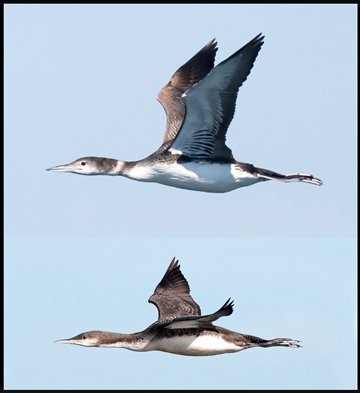 Images play a major role in illustrating flight and flocking traits, as well as depicting the multitide of patterns and silhouettes and plumage details a birder needs to observe during seawatching. Photographs constitute at least 50 percent of the Species Accounts. Some are strikingly beautiful (see the 2-page photograph of two adult Ivory Gulls in flight by Brandon Holder), many are good, and many more are challenging, images of hardly distinguishable distant birds. This is, of course, because this is a book about how to identify hardly distinguishable distant birds. The photographs have been selected carefully to illustrate the distinctive shape and “feel” of the species, how the bird appears in its environment, and reflecting what a birder is apt to see in the field. In a few cases, such as this image of Pacific and Common Loons by Brian Sullivan, composites are used.
Images play a major role in illustrating flight and flocking traits, as well as depicting the multitide of patterns and silhouettes and plumage details a birder needs to observe during seawatching. Photographs constitute at least 50 percent of the Species Accounts. Some are strikingly beautiful (see the 2-page photograph of two adult Ivory Gulls in flight by Brandon Holder), many are good, and many more are challenging, images of hardly distinguishable distant birds. This is, of course, because this is a book about how to identify hardly distinguishable distant birds. The photographs have been selected carefully to illustrate the distinctive shape and “feel” of the species, how the bird appears in its environment, and reflecting what a birder is apt to see in the field. In a few cases, such as this image of Pacific and Common Loons by Brian Sullivan, composites are used.
Captions detail out significant identification points in bullet-pointed text, sometimes with added information on the effect of light and distance. This is a great feature for those of us who tend to read up on a species quickly, right before a field trip. Some photos include quiz questions, a feature that has become de rigueur in modern birding guides. Answers are given in the Appendix, often with the reasoning behind the identification. Most of the photographs are by the authors. Additional photos are by a talented collection of photographers, many of them birders whose names will be familiar to those who frequent Flickr and other Internet photographic sites.
The second part of the Peterson Reference Guide to Seawatching is about place–Where to Watch. I was surprised to find out that seawatching is not limited to the ocean. You can seawatch at a lake, a river, even, the authors say, at a cornfield. Of course, there are those times after a great storm when every inland water body holds the potential for storm-petrels and rare gulls, but this listing is focused on the expected rather than the unexpected, both on the coast and inland. Forty-seven sites are described here, ranging from interior sites like Whitefish Point, Michigan and Conejohela Flats, Pennsylvania to coastal sites like the Cape May Avalon seawatch in New Jersey and Brier Island, Nova Scotia.
Some of these are well-established migration counting points; others have been included for their potential. Information on the sites has been gathered from local experts and includes a Description of the location, Timing–the best time of the year and day to seawatch, what winds are most favorable, and Birds–what birds can be expected and when. Top ten counts are given for the larger sites, and the authors have compiled a table of the top three single-day counts for 75 of the 112 species covered in the book. To my knowledge, this is the first compilation of seawatching sites in the eastern part of North America. It’s a great start. Hopefully, those regions without top ten lists will soon be filled in. It is both discouraging and exciting to read that little is known about waterbird migration along the Mississippi River.
Pelagics are not covered at all by this book, though I am sure these identification techniques will be invaluable to any birder who embarks on a day or two or three at sea.
The Appendices include three items that I think are essential to a book called a Reference Guide: Glossary, Bibliography, and Index. The Glossary is brief, two pages; it covers many of the more technical terms used in the Species Accounts and I like the definitions, which are clearly written. Still, the beginner will need to refer to the bird anatomy diagrams in the Introduction to understand the meaning of some of the terms used in definitions (I needed to look up “alula”). The two-and-a-quarter page Bibliography is excellent, an up-to-date (as of 2011, which is pretty good for a book published in late 2013) mix of identification guides and articles and web sites, including titles on European seabird identification. The Index lists birds by common and scientific name and the places listed in the Where section. A nice feature is that the photographs are also indexed here, indicated by bold print.
Surprisingly for a book as well planned as this one, there is no table of contents of individual species accounts. The Contents page simply list the pages for the Species Account groups. This means, for example, that I needed to check the Index to find out that Seawatching includes Brown and Masked Booby (in the Sulids section) but not Red-footed Booby. This makes researching a species much more time consuming than it should be. You need to either browse through the Species Accounts or search the index by the exact name of the species. It also means that the only way to knew about the special sections on Scoters and Mixed Ducks is by reading the book page-by-page or by reading the Index. Not many people read an index. I hope that, like many other reference book authors, Behrens and Cox will consider supplementing this excellent book with an online table of contents to species and special sections. It would help birders use the book more efficiently and also bring attention to these extremely helpful special sections.
The authors, Ken Behrens and Cameron Cox, are both birders who spent their teen and younger years birding and working at birding jobs around the world. They were part of the team that broke the ABA Big Day record in 2008 with 260 species. Ken Behrens was ABA/Leica Young Birder of the Year in 1999, and has worked for the Rocky Mountain Bird Observatory and spent parts of three years counting birds at Cape May. He is currently a birding tour guide for Tropical Birding, based in Madagascar, and has co-authored a book on Birding Ethiopia. Cameron Cox describes himself as a “bird bum”. He has worked as the birder representative for Leica and Nikon, and is currently a tour leader for Tropical Birding. Clearly an identification junkie, the author of a three-part article on shorebirds and co-author of a Birding article on Aging of American and EurasianWigeons in Female-type Plumages (2005), Cox too counted birds at Cape May. The knowledge and skills represented in the Peterson Reference Guide to Seawatching reflects Behrens and Cox’s “street” (or should I say “sea”?) knowledge of bird identification and their passion for this very specific subset of birding.
The Peterson Reference Guide to Seawatching: Eastern Birds in Flight is a unique identification guide. It will be, I think, the answer to many birders’ prayers and an eye-opening introduction for many others. The authors have collected and codified identification expertise previously undocumented or explained in subjective, changing language, and present this knowledge in an engaging guide that combines text and photographs seamlessly. This is a book that every advanced birder on the east coast will want. At $35 retail, I suspect some will hesitate. Don’t. It’s worth it. Beginner and intermediate birders should consider if seawatching is a birding area they want to explore. I think some of this decision will be based on where you live. For those of us situated near the ocean or the Great Lakes, seawatching might be something we are already doing, only we don’t know it has a name. If you enjoy looking at birds flying over the ocean, I think this is a book worth purchasing regardless of birding skill level. You’re not going to find composite comparison photos of Roseate, Common, and Forster’s Terns in flight in your typical field guide. Birders who live on the west coast are at a disadvantage here. There is some overlap of waterbird species, but many, especially in the cormorant, alcid, and tubenose groups that are not represented. The solution is obvious: a new title for the Peterson Reference Guide series, Seawatching Part 2: Western Waterbirds in Flight. I hope Behrens and Cox are paying attention!
——————————-
Peterson Reference Guide to Seawatching : Eastern Waterbirds in Flight
By Ken Behrens and Cameron Cox.
Peterson Reference Guides Series, Houghton Mifflin Harcourt, 624 pages.
Publication date: September 17, 2013.
ISBN-10: 0547237391; $35.00 retail.


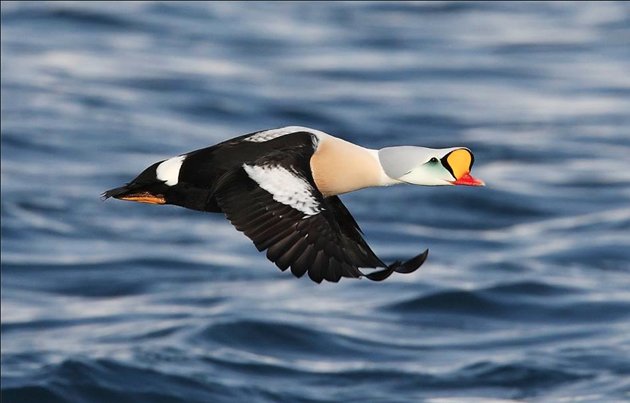
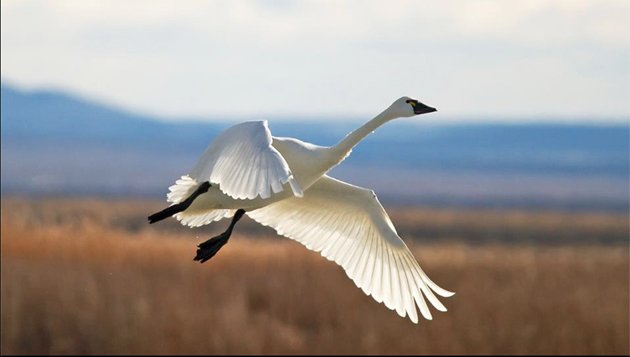
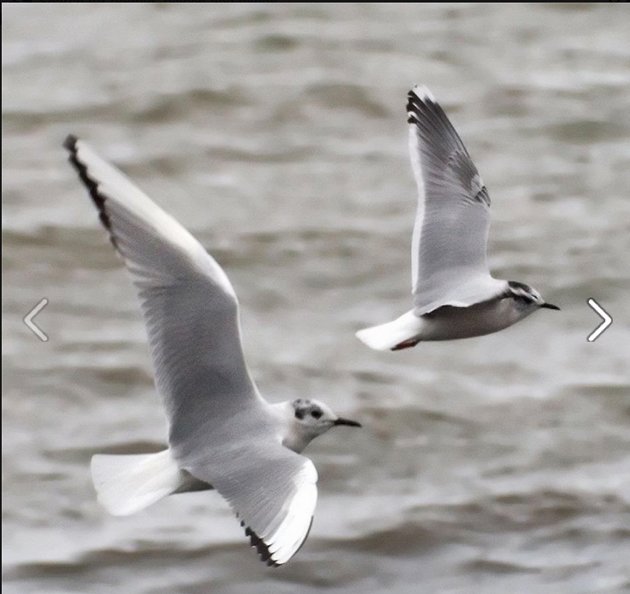
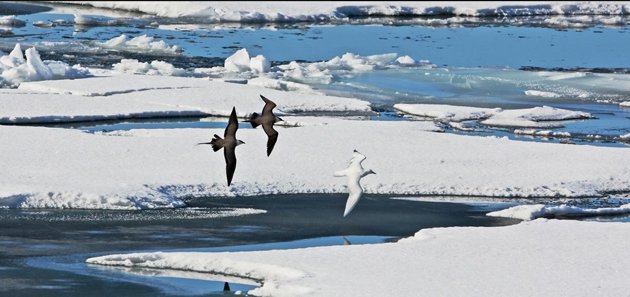




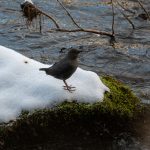
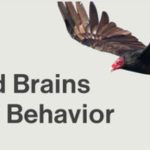





Leave a Comment